Fonte do vídeo: http://www.youtube.com/watch?v=DFTuvrm_6Hw
18 de fev. de 2012
I dream of Jeannie
Do you like tv series? I like it so much, specially I dream of Jeannie.
Now I would like to share with you a search that I did about this tv series.
So... I want you enjoy!!
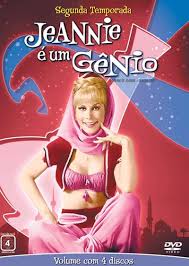
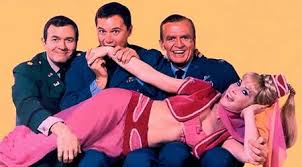
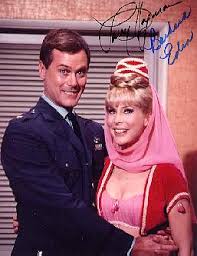
 =====>
=====> 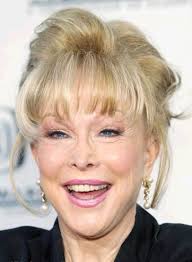
 ====>
====> 
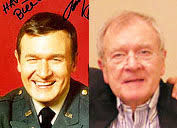
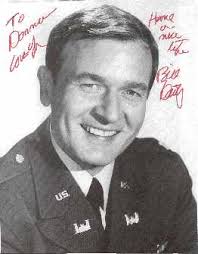 ===>
===> 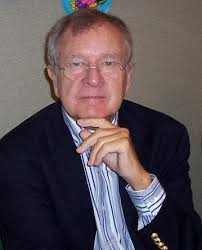
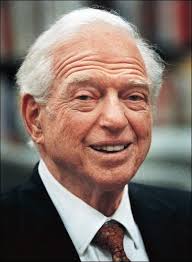
Now I would like to share with you a search that I did about this tv series.
So... I want you enjoy!!
(...)
The original story
In the pilot episode, "The Lady in the Bottle", astronaut Captain Tony Nelson, US Air Force, is on a space flight when his one-man capsule Stardust One comes down far from the planned recovery area, near a deserted island in the South Pacific. On the beach, Tony notices a strange bottle that rolls by itself. When he rubs it after removing the stopper, smoke starts shooting out and a Persian-speaking female genie (wearing an enticing harem costume) materializes and kisses Tony on the lips with passion, shocking him. (In the second season's animated opening, it's a kiss on the cheek and Tony is happy to receive it.)
They cannot understand each other until Tony expresses his wish that Jeannie (a homophone of genie) could speak English, which she then does. Then, per his instructions, she "blinks" and causes a recovery helicopter to show up to rescue Tony, who is so grateful that he tells her she's free. But Jeannie, who has fallen in love with Tony at first sight after being trapped for 2000 years, re-enters her bottle and places it in Tony's duffel bag so she can accompany him back home. One of the first things Jeannie does, in a subsequent episode, is break up Tony's engagement to his commanding general's daughter, who, along with that particular general, is never seen again. (This event reflects producer Sidney Sheldon's decision that the engagement depicted in the pilot episode would not be part of the series continuity; he realized the romantic triangle he created between Jeannie, "Master" and Melissa Stone wouldn't pan out in the long run.)
Tony at first keeps Jeannie in her bottle most of the time, but finally relents and allows her to enjoy a life of her own. However, "her" life is devoted mostly to his, and most of their problems stem from her love and affection towards "Master", and her desire to "please" him and fulfill her ancient heritage as a genie – especially when he doesn't want her to do so. His efforts to cover up Jeannie's antics, because of his fear that he would be dismissed from the space program if her existence were known, brings him to the attention of NASA's resident psychiatrist, US Air Force Colonel Dr. Alfred Bellows. In a running gag, Dr. Bellows tries over and over to prove to his superiors that Tony is either crazy or hiding something, but he is always foiled ("He's done it to me, again") and Tony's job remains secure. A frequently used plot device is that Jeannie loses her powers when she is confined in a closed space. She is unable to leave her bottle when it is corked, and under certain circumstances the person who removed the cork would become her new master. A multi-episode story arc (see below) involves Jeannie (in miniature) becoming trapped in a safe when it is accidentally locked.
Tony's best friend and fellow astronaut, US Army Corps of Engineers Captain Roger Healey, doesn't know about Jeannie for several episodes – when he finds out (in the episode "The Richest Astronaut In the Whole Wide World" [January 15, 1966]), he steals her so he can live in luxury. It's not long though before Tony reclaims his status as Jeannie's master. Roger continues to demonstrate his desire to use Jeannie's powers for his own "selfish" benefit, but for the most part he respects Tony's status as Jeannie's master. Both Tony and Roger are promoted to the rank of major late in the first season.
Jeannie's sister, mentioned in a second-season episode (and also named Jeannie), proves to have a mean streak starting in the third season (demonstrated in her initial appearance in "Jeannie or the Tiger?" [September 19, 1967]), repeatedly trying to steal Tony for herself, with her as the real "master". Her final attempt in the series comes right after Tony and Jeannie get married, with a ploy involving a man played by Barbara Eden's real-life husband at the time, Michael Ansara (in a kind of in-joke, while Jeannie's sister pretends to be attracted to him, she privately scoffs at him).
Early in the fifth season [September 30, 1969], Jeannie is called upon by her Uncle Sully (Jackie Coogan) to become queen of their family's native country, Basenji. Tony inadvertently gives grave offense to Basenji national pride in their feud with neighboring Kasja. To regain favor, Tony is required by Sully to marry Jeannie and avenge Basenji's honor, by killing the ambassador from Kasja when he visits NASA. After Sully puts Tony through an ordeal of nearly killing the ambassador, Tony responds in a fit of anger that he is fed up with Sully and his cohorts and he wouldn't marry Jeannie if she were "the last genie on earth." Hearing this, Jeannie bitterly leaves Tony and returns to Basenji. With Jeannie gone, Tony realizes how deeply he loves her. That outweighs all concerns he has had about Jeannie's threat to his career. He flies to Basenji to win Jeannie back. Upon their return to NASA, Tony introduces Jeannie as his fiancée. The two get married several weeks later. The public introduction of Jeannie heralds a change in the series continuity: The secret is no longer Jeannie's existence, but merely that she possesses magical powers, contrary to the mythology created by Sidney Sheldon's own Season 2 script for "The Birds and Bees Bit" in which it was claimed that upon marriage, a genie loses all of her magical powers.
Sidney Sheldon and the cast fought against the marriage, feeling it would ruin the sexual tension between the two. Even with the series finishing its fourth season in 26th place, NBC was going to cancel the program if Jeannie and Tony did not wed [Sheldon later referred to the network's ultimatum as "blackmail"]. For the fifth season (1969–70), NBC moved the series to a weak time slot (Tuesday at 7:30 p.m. Eastern/Pacific Time) where it had had mediocre ratings during its third season (1967–68).(...).
Fonte do texto: http://en.wikipedia.org/wiki/I_Dream_of_Jeannie
About the actress :
Eden was born Barbara Jean Morehead in Tucson, Arizona, the daughter of Alice Mary (née Franklin) and Hubert Henry Morehead. Her parents divorced when she was three; she and her mother Alice moved to San Francisco where later her mother married Harrison Connor Huffman, a telephone lineman. The Great Depression deeply affected the Huffman family, and as they were unable to afford many luxuries, Barbara's mother entertained the children by singing songs. This musical background left a lasting impression on the actress, who began taking acting classes because she felt it might help her improve her singing.
Her first public performance was singing in the church choir. She was always doing the solos. When she was 14 she was singing in local bands for $10 a night in night clubs. At age 16 she became a member of Actor's Equity. She studied singing at the Conservatory of Music in San Francisco and acting with the Elizabeth Holloway School of Theatre. She graduated from Abraham Lincoln High School in San Francisco in the Spring Class of 1949[1] and studied theater for one year at City College of San Francisco. Then she was elected Miss San Francisco, as Barbara Huffman, in 1951. Barbara also entered the Miss California pageant, but did not win. [2][3]
Fonte do texto: http://en.wikipedia.org/wiki/Barbara_Eden
Fonte do texto: http://en.wikipedia.org/wiki/Barbara_Eden
About the actor: Larry Hagman
Hagman was born in Fort Worth, Texas. His mother, Mary Martin, later became a Broadway actress and his father, Benjamin Jack Hagman,[1] was a district attorney. His parents divorced in 1936 when he was five years old. He lived with his grandmother in Texas and California. His famous mother became a contract player with Paramount in 1938 and occasionally took him to her movies.
In 1940 his mother met and married Richard Halliday and gave birth to a daughter, Heller, the following year.[citation needed] Hagman attended the strict Black-Foxe Military Institute (now closed). When his mother moved to New York City to continue her Broadway career, Hagman again lived with his grandmother in California.[citation needed] A couple of years later, his grandmother died and Hagman joined his mother in New York. At age 14 (in 1945) while attending boarding school, he began drinking heavily which led to serious health problems later in life.[citation needed]
In 1946 Hagman moved back to his hometown of Weatherford, where he worked on a ranch owned by a friend of his father. After attending Weatherford High School, he was drawn to drama classes and reputedly fell in love with the stage and, in particular, with the warm reception he got for his comedic roles. He developed a reputation as a talented performer and in between school terms, would take minor roles in local stage productions.[citation needed] Hagman graduated from high school in 1949, when his mother suggested that he try acting as a profession.[citation needed]
Hagman began his career in Dallas, Texas working as a production assistant and acting in small roles in Margo Jones' Theater in 1950 during a break from his one year at Bard College. He appeared in The Taming of the Shrew in New York City, followed by numerous tent show musicals with St. John Terrell's Music Circus in St. Petersburg, Florida, and Lambertville, New Jersey. In 1951, Hagman appeared in the London production of South Pacific with his mother, and stayed in the show for nearly a year.
In 1952, during the Korean War, Hagman was drafted into the United States Air Force.[citation needed] Stationed in London, he spent the majority of his military service entertaining U.S. troops in the UK and at bases in Europe.[citation needed]
About the actor: Bill Daily
Bill Daily (born August 30, 1927) is an American comedian and dramatic actor, and a veteran of many television sitcoms. He is best known for playing astronaut Roger Healey on I Dream of Jeannie and commercial airline navigator Howard Borden on The Bob Newhart Show.
Daily's father died when Bill was very young, and he was raised by his mother and various other family members. In 1939, Daily and his family moved to Chicago, where he spent the rest of his youth. Upon leaving Lane Technical High School, Daily left home to try to carve out a life as a musician, playing bass with jazz bands in numerous clubs across the Midwest.
Bill was drafted into the Army and served in Korea with an artillery unit, later being transferred to an entertainment unit.
It was in his traveling-musician days that Daily found his true calling: comedy. He began to do stand-up in the same clubs he had once filled with music, and he soon moved up in the comedy ranks to the point where he was playing some of the bigger clubs in the country.
After graduating from the Goodman Theatre School, Daily worked for the NBC television station in Chicago, WMAQ, as an announcer and floor manager. He eventually became a staff director. Daily recently recalled for PBS how one day, preparing for a Chicago-area Emmy Award telecast, he asked a young local comedian to come up with a routine about press agents. The bit, "Abe Lincoln vs. Madison Avenue," became an early hit for the performer—a young Bob Newhart.
Fonte do texto: http://en.wikipedia.org/wiki/Bill_Daily
The great author:
Sidney Sheldon (February 11, 1917 – January 30, 2007) was an Academy Award-winning American writer. His TV works spanned a 20-year period during which he created The Patty Duke Show (1963–66), I Dream of Jeannie (1965–70) and Hart to Hart (1979–84), but he became most famous after he turned 50 and began writing best-selling novels such as Master of the Game (1982), The Other Side of Midnight (1973) and Rage of Angels (1980). He is the sixth best selling writer of all time.
Sheldon was born Sidney Schechtel in Chicago, Illinois. His parents, of Russian Jewish ancestry, were Ascher "Otto" Schechtel (1894–1967), manager of a jewelry store, and Natalie Marcus. At 10, Sidney made his first sale, $5 for a poem. During the Depression, he worked at a variety of jobs, and after graduating from Denver East High School, he attended Northwestern University and contributed short plays to drama groups. He is the author of 18 novels (which have sold over 300 million copies), over 200 television scripts, 25 major motion pictures and 6 Broadway plays.
Fonte do texto: http://en.wikipedia.org/wiki/Sidney_Sheldon
I like this series. I think that when somebody watches it somebody likes it immediately.
Thanks Sidney Sheldon, the cast and productin for make it.
13 de fev. de 2012
Introducing people
Para compreendermos como devemos proceder para apresentarmos pessoas coloco este vídeo:
Fonte: http://www.youtube.com/watch?v=kQ6hSlhKIkc&feature=related
Fonte: http://www.youtube.com/watch?v=kQ6hSlhKIkc&feature=related
Em relação ao seu nome....
Nomes...
Quando estiver sendo apresentado diga sempre seu nome completo.
Exemplo: Hello, I'm Maria da Silva.
Se estiver em situação que seja informal diga apenas seu primeiro nome.
Exemplo: Hi, I'm Maria.
Sempre trate seus professores ou chefes de trabalho pelo pronome de tratamento adequado e sobrenome.
Exemplo: Miss Silva; Mister Sullivan;

Quando estiver sendo apresentado diga sempre seu nome completo.
Exemplo: Hello, I'm Maria da Silva.
Se estiver em situação que seja informal diga apenas seu primeiro nome.
Exemplo: Hi, I'm Maria.
Sempre trate seus professores ou chefes de trabalho pelo pronome de tratamento adequado e sobrenome.
Exemplo: Miss Silva; Mister Sullivan;
Conhecendo costumes e hábitos dos norte americanos....
Conhecendo alguém...
Qaundo for apresentado a alguém: costuma-se dar as mãos em um gesto conhecido com "shake hands" ou aperto de mãos.

Não é de costume dar abraços ou beijos em pessoas que você acabou de conhecer. Deixe estes gestos, mais próximos, somente para seus amigos, ok?
Fonte de pesquisa: http://tm-blueberry.blogspot.com/2010/10/habitos-e-costumes-dos-americanos.html
Qaundo for apresentado a alguém: costuma-se dar as mãos em um gesto conhecido com "shake hands" ou aperto de mãos.
Fonte de pesquisa: http://tm-blueberry.blogspot.com/2010/10/habitos-e-costumes-dos-americanos.html
12 de fev. de 2012
Wando

Singela homenagem ao último romântico
Dear friend Wando,
Brazil will miss you!!
God bless you!
Rest in peace.
LUTO
Wando morou e foi feirante em Volta Redonda
Wando morou e foi feirante em Volta Redonda
| Publicado em 8/2/2012, às 09h25 | |||||
| Última atualização em 8/2/2012, às 18h10 | |||||
A cidade fez parte da início da carreira do cantor Wando, que morreu na manhã de hoje (7), aos 66 anos, em decorrência de infarto seguido de parada cardíaca. A morte ocorreu depois de 13 dias de internação no Hospital Biocor, em Nova Lima (MG). Vanderley Alves dos Reis passou o período da adolescência em Volta Redonda. Ele entregou leite em casas, vendeu jornal, foi feirante e dirigiu caminhão. Na mesma época, teria se interessado pela música e aprendeu a tocar violão clássico. Por oito anos morou em uma casa simples no bairro Minerlândia. O menino de 10 anos ajudava o comerciante Celso do Carmo, que já morreu, a selecionar frutas para vender na feira livre. Josefina Maria de Andrade mora vem frente à antiga casa do cantor, na Rua Varginha. - Ele era um menino humilde e muito trabalhador. Sempre o via mexendo com as frutas e na carroça. O menino era esguio, bem vistoso e brincalhão. Wando ficou aqui até uns 18 anos, nesse período nunca o vi cantar. Até me surpreendi quando ele começou a fazer sucesso - disse. Rute do Carmo, irmã de Celso do Carmo, lembra um pouco do rapaz, quando ele era comerciante: - Não sei muito da história do Wando em Volta Redonda, mas sei que trabalhou por muitos anos com o meu irmão. Celso adorava pessoas que tinham o dom com a música, ele levava os meninos para cantar na churrascaria. Era um grande incentivador da cultura e o Wando fez parte disso. Wando trabalhou muitos anos na feira livre e fez grandes amizades. Como o antigo sócio Mauro Dias Rocha, conhecido como Marinho da Sessenta, que recorda com saudade os tempos de serestas. - Sou filho de mãe viúva e estava trabalhando na feira quando conheci o Wando, tínhamos uns 15 anos. Depois do dia de vendas na nossa barraca, saíamos às 13h. Às 19h, ele me chamava para fazermos seresta. Cantávamos em um bar, onde fazíamos uma espécie de galinhada, já que na época não tinha churrasco - falou. Marinho da Sessenta lembra de muitos momentos que passou ao lado do amigo: - Tínhamos uma carroça muito pobre. Existia outro feirante, o Ventura, que vendia flores, o cavalo dele era branco e a carroça, linda. Wando sonhava com ela e queria ter uma igual. Quando ganhávamos um pouco de dinheiro, ele comprava uma coisinha ou outra para tentar melhorar a nossa. Mas nunca ficou igual à do Ventura. Sucesso com as mulheres começou cedo Mauro Dias Rocha, o Marinho da Sessenta, lembra que o sucesso de Wando com as mulheres começou cedo. - Quando morava em Volta Redonda, Wando não recebia calcinhas das mulheres. Porém, já estava sendo assediado, e ele era tão feio - diverte-se. A separação dos amigos aconteceu depois dos 18 anos. - Tive que ir para o Exército, depois fui trabalhar na CSN (Companhia Siderúrgica Nacional). Mas quando voltei do meu serviço militar, Wando já tinha ido embora. Fiquei sabendo que uma senhora o ajudou, financiando o início da carreira. Há 15 anos nos encontramos em um sítio em Cachoeira de Macacu (RJ), conversamos e me chamou para visitar a casa dele - contou o técnico de qualidade. Vendedor de bananas A comerciante Ana Célia da Silva Ferreira lembra que o concunhado dela, que hoje mora nos Estados Unidos, contava que era muito amigo do cantor Wando. - Como vendiam bananas, eles se chamavam de Bananeira. Depois que o Wando saiu de Volta Redonda o meu concunhado abriu uma floricultura no Rio de Janeiro. Quando foi fazer uma entrega para um cliente, quem abriu a porta foi o Wando. Ele conta que os dois se emocionaram e se abraçaram muito. Meu concunhado ficou muito feliz - disse. Ao sair de Volta Redonda, Wando ficou conhecido do grande público com sucessos,como "Fogo e paixão", "Gosto de maçã", "Moça" e "Coisa Cristalina". A marca do cantor era a coleção de calcinhas feita a partir de presentes das fãs. | |||||
Assinar:
Postagens (Atom)

